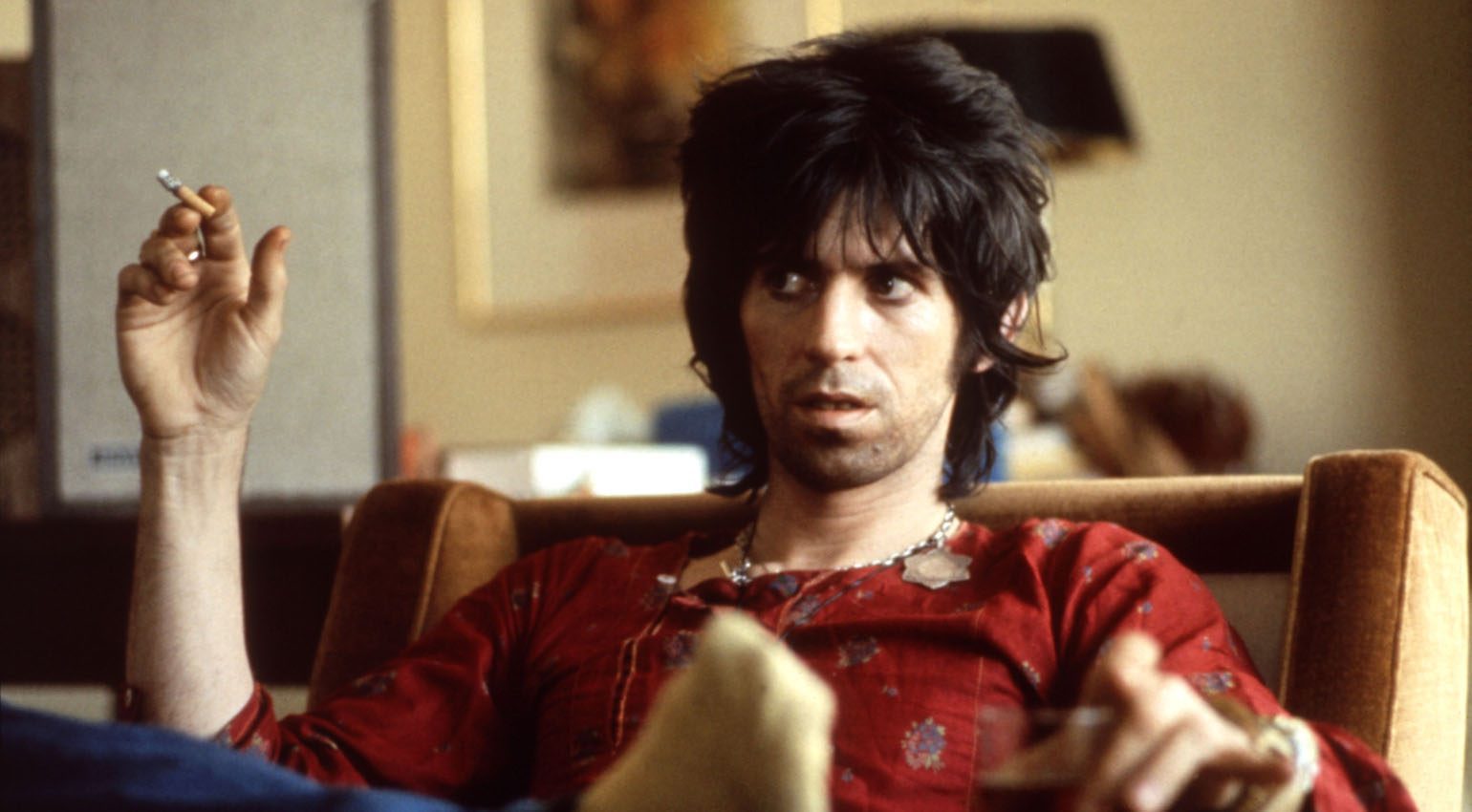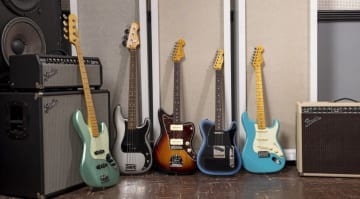Keith Richards’ Guitars – A long way to Hackney Diamonds
The Rolling Stones' guitarists instruments over the years
We take the 24th (!!!) album “Hackney Diamonds” of the veterans of rock, which will be released on October 20, as an opportunity to bring the instruments of “Keef” to the Gearnews stage. Let’s look at some tips and tricks on how to get Keith’ sound at home – Keith Richards’ guitars!
The Rolling Stones are much more than just a rock band. They are a musical phenomenon that has shaped the music world for decades. While drummer Charlie Watts laid the rhythmic foundation like few could with his precise drumming. And Mick Jagger made the audience frenzy with his charismatic voice and stage presence. It was and still is Keith Richards who embodies the band’s musical soul.
His sound, characterized by a deep love of vintage instruments and a distinctive playing style, is what made the Stones’ songs in many occasions.
When thinking of Keith Richards’ guitars, the first thing that comes to mind for many is a Fender Telecaster in Butterscotch Blonde. In particular, “Micawber,” as he calls his number one. But Keith’s musical journey began much earlier.
The early years (1960-’64) – Keith Richards’ guitars

Already a star when he was young – Keith Richards · Source: Trinity Mirror / Mirrorpix / Alamy Stock Foto
In the early days of his musical career, Keith Richards’ arsenal of guitars was still modest. His first guitar was a Rosetti acoustic, a gift from his mother. Keith learned the first song, “Malagueña,” on it, taught to him by his grandfather.
When the Rolling Stones entered the studio to record their debut album in 1964, Richard brought his first electric guitar, a Harmony Meteor H70. The instrument helped define the early Stones’ sound and solidified Richards’ status as an emerging guitar virtuoso.
Satisfaction? Not quite yet …
In the mid-60s, a decisive phase in the musical development of Richards began. The “Keef ‘Burst”, a special Gibson Les Paul, became one of his main instruments and it was constantly present during the “Out of Our Heads” sessions. This guitar gained special notoriety among Kieth Richards’ guitars. Because Richards used not only the Les Paul, but also a then brand-new effects pedal, the Maestro FZ-1 Fuzz-Tone, for the unforgettable riff of “(I Can’t Get No) Satisfaction.”
This song marked a turning point in music history and established the Stones as pioneers in rock music. During this time, Keith Richards also experimented with other guitars, including an electric 12-string for “Mother’s Little Helper” and a Guild M-65 Freshman. But despite his love of experimentation, the Keef ‘Burst remained his most constant guitar through the turbulent 1960s.
You are currently viewing a placeholder content from YouTube. To access the actual content, click the button below. Please note that doing so will share data with third-party providers.
Few other guitars today are so closely associated with Keith Richards as the Fender Telecaster. Especially the “Micawber”, a 1950 Telecaster in Butterscotch Blonde. It was a birthday gift from Eric Clapton, and it quickly became an indispensable part of the Stones’ sound. “Micawber” not only witnessed the creation of the legendary album “Exile On Main St.,”. Richards himself also modified the guitar.
He removed the low E string and continued experimenting with open G tunings. Additional modifications, such as a Gibson PAF humbucker on the neck and a pedal steel pickup on the bridge, made this guitar a unique instrument. By the way, the name Micawber comes from the novel “David Copperfield” by Charles Dickens.
The seventies – an era of experiments in Keith Richards’ guitars
Micawber was only the first in a series of guitars that Richards collected and modified during that decade. He was constantly on the lookout for new sounds and expressions. Another notable of Keith Richards’ guitars from that time was a special Gibson Les Paul Jr, also known as “Dice”, which he often used on stage.
The Rolling Stones guitarist always found what he was looking for, even with smaller manufacturers: Travis Bean guitars with aluminum necks were one of his passions, the unique Zemaitis guitars with their skull design another. Despite his love of experimentation, his approach always remained straightforward: It was all about getting the best out of each instrument and adapting it to his musical needs.
Keith Richards today – new ways, old guitars?
I bet we won’t ever witness the day that Keith Richards will be on stage without a guitar. Ye, something has changed in recent years: Richards struggles with arthritis, which has affected his guitar style and the way he plays.
Still, Keith said in an interview with the BBC that this change in his playing style has opened new doors for him and inspired him to evolve and find new ways to express his music. You can read the whole interview here: Keith Richards in BBC interview
Hackney Diamonds
You are currently viewing a placeholder content from YouTube. To access the actual content, click the button below. Please note that doing so will share data with third-party providers.
Just last week, the Stones released “Hackney Diamonds,” their first studio album in 18 years. The album was recorded in several studios, including Electric Lady Studios in New York and Henson Recording Studios in Los Angeles. It featured guest appearances by Elton John, Lady Gaga, Paul McCartney, Stevie Wonder, and Bill Wyman. And also some of the last studio recordings of the late drummer Charlie Watts.
Unfortunately, there are no specific details known about Keith Richards’ guitars for the album “Hackney Diamonds”. So we can all be curious about what the master has taken under his fingers for this event!
The sound of Keith Richards – guitars, amps and … tape recorders?
If you have the chance to grab Micawber – go for it. For everyone else, here are some gear tips that will get you close to Keith’s sound without stealing the crown jewels.
Electric Guitar: Maybach Teleman T52-2 Butterscotch Blonde
My number one pick would have to be a Fender Telecaster. But a “proper” new Tele just doesn’t bring the rocked-out charm and the squeezing humbucker sound on the neck. As a European manufacturer, Maybach has become particularly well known for its reinterpretations of classic instruments and delivers a beautiful variation on the classic Telecaster with the Teleman.
The Amber Spirit of ’59 humbucker sings clear and strong, the nitro lacquer has aged beautifully, and the whole thing comes in perfectly set-up condition.


Acoustic: Gibson Hummingbird
Yes, acoustic guitars also play a big role in the musical work of Keith Richards: “Street Fighting Man”, “Not Fade Away”, “Brown Sugar”, “Angie”, “Wild Horses” or “Jumping Jack Flash” were written and recorded on a Hummingbird.
The iconic acoustic guitar has been unchanged for decades, but there are different versions. My tip (from personal experience): The Gibson Hummingbird Original AN with a mahogany body and solid spruce top also brings a high-quality pickup system – so songs can be recorded quickly and easily without resorting to the good old cassette recorder.


Recording: Philips cassette recorder, portable
Legend has it that Keith and drummer Charlie Watts recorded the song “Street Fighting Man” on a portable Philips cassette recorder. The built-in microphone was so overwhelmed by the Hummingbird’s sound that the acoustic instrument’s recordings turned into an almost harsh electric guitar sound.
Retro-love or not – we don’t have a real recommendation for this nowadays.
Amps: Fender Champ
Cassette recorders aside, most of Keith Richards’ guitar sound comes from his classic tube amps. One most images from Keith playing on stage or in the studio, you can see him using two Fender Champs with 8″ speakers. The rather low-power amp delivers exactly the level of distortion that is so characteristic of the cutting sound of his guitars.


Effects: Ibanez Tubescreamer TS9
When things need to be louder, the Stones sometimes use the distortion powers of the small, green Japanese pedal: The pedal’s ability to blow on delicate tube amps without getting muddy has become legendary.
Just be careful: Too much distortion and the tape recorder won’t be able to keep up … Otherwise, Keith Richards is usually satisfied just with his guitars – you won’t find huge pedalboards or expression gimmicks around him – keep it simple.


Go on and on
It’s hard to imagine that the Rolling Stones’ musical journey will eventually come to an end. We have become so accustomed to the existence of this living museum of rock ‘n’ roll that it seems almost normal when the “boys” release another album.
“Hackney Diamonds” will be a smash hit – we can be sure of that.
You are currently viewing a placeholder content from Default. To access the actual content, click the button below. Please note that doing so will share data with third-party providers.
Originally published at Gearnews.de by Jan Rotring. Translation by Julian Schmauch.
More info on Keith Richards guitars and gear:
- The most used guitars, amps and co.
- Keith Richards about the recording process of Exile on Main St.
- Insight into the intricacies of the Rolling Stones’ gear
- Keith Richards on the influence of aging
Videos from the new Stones Album „Hackney Diamonds“
You are currently viewing a placeholder content from YouTube. To access the actual content, click the button below. Please note that doing so will share data with third-party providers.
You are currently viewing a placeholder content from YouTube. To access the actual content, click the button below. Please note that doing so will share data with third-party providers.
You are currently viewing a placeholder content from YouTube. To access the actual content, click the button below. Please note that doing so will share data with third-party providers.
*This post contains affiliate links and/or widgets. When you buy a product via our affiliate partner, we receive a small commission that helps support what we do. Don’t worry, you pay the same price. Thanks for your support!
 4,3 / 5,0 |
4,3 / 5,0 | 









